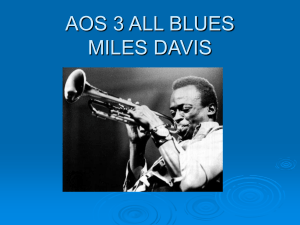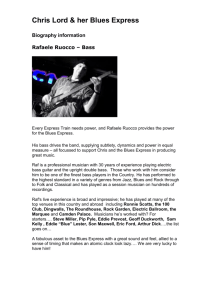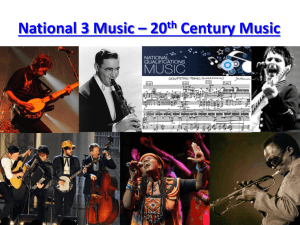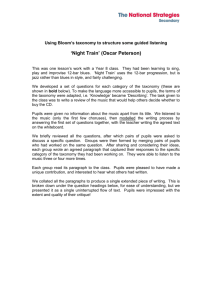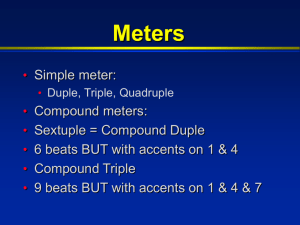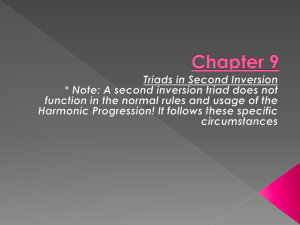aos 3 kind of blue miles davis
advertisement
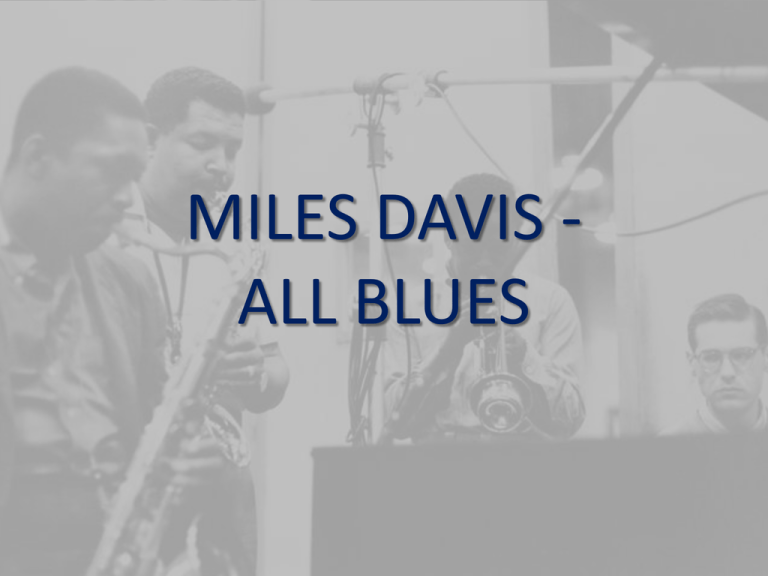
MILES DAVIS ALL BLUES KIND OF BLUE - 1959 All Blues • This track is from the album KIND OF BLUE and was recorded in one take in New York in 1959 • Each track on the album, including this one, had only one take and the whole album was recorded in three 3 hour sessions • Rarely, all the musicians were at the height of their playing abilities when this was recorded • MILES DAVIS gave his band the minimum of preparation for this track before they went into the studio in New York in 1959 – They were just given some MODES (Scales) and melody lines to improvise around • This is MODAL JAZZ – this means that rather than relying on complicated chord patterns and PLAYING THE CHANGES, the solos are built from the chosen MODES. This means the improvisations are longer and much freer. • Unusually for Jazz the time signature is 6/4 and is marked JAZZ WALTZ The bandMILES DAVIS - trumpet CANNONBALL ADDERLEY - alto sax JOHN COLTRANE - tenor sax JIMMY COBB - drums BILL EVANS – piano PAUL CHAMBERS - bass The Instruments & Their Roles • The frontline instruments are the TRUMPET, ALTO SAXOPHONE & TENOR SAXOPHONE. They play the IMPROVISED SOLOS • The RHYTHM section provides the harmonic and rhythmic background - in this case it is the DRUMS / BASS / PIANO • The Piano COMPS chords underneath the 3 solos. COMPING is a Jazz term for accompanying • The Bass is very repetitive throughout – it deliberately doesn’t detract from the improvisations Structure of ALL BLUES In total All Blues plays the 12 Bar Blues pattern 19 times with short link passages in between each main section. Structural Overview: • INTRO • HEAD – this is where the original tune or melody is played • IMPROVISED SOLOS - trumpet / alto sax / tenor sax / piano • HEAD - the main theme returns • OUTRO - this fades out This is the chord pattern for a standard 12 bar blues: Bar 1 Bar 2 Bar 3 Bar 4 G G G G Bar 5 Bar 6 Bar 7 Bar 8 C C G G Bar 9 Bar 10 Bar 11 Bar 12 D C G G/C This is the chord pattern used in All Blues: Bar 1 Bar 2 Bar 3 Bar 4 G7 G7 G7 G7 Bar 5 Bar 6 Bar 7 Bar 8 C7 C7 G7 G7 Bar 9 Bar 10 Bar 11 Bar 12 D7#9 Eb7#9 D7#9 G7 G7 • All Blues uses EXTENDED CHORDS such as DOMINANT 7ths, and the last line also uses ALTERED CHORDS • A Dominant 7th is a normal triad with the 7th note above the bass added • Adding a 7th, 9th or even an 11th to a triad turns it into an EXTENDED CHORD • A #9 chord works on the same idea, you add the 9th note above the root and sharpen it (This is the same as adding a sharpened 2nd) • Sharpening or Flattening a note makes a chord an ALTERED CHORD – such as D7#9 and Eb7#9 Chord Voicing • Bill Evans keeps the piano part interesting while COMPING by constantly changing the CHORD VOICING • Changing the voicing means simply changing the order of notes in a chord • Changing which notes are at the top, bottom or middle, and how far they spread over the piano can dramatically change the way a chord sounds RIFFS – What are they? • A RIFF is a short repeated phrase, or the modern name for an ostinato – Riffs are very common in Jazz, Blues & Pop. • All Blues is based on 2 short riffs – The first is played by the Double Bass throughout most of the piece – The second is the rising and falling 3rds played mainly by the alto and tenor saxes, and occasionally the piano
